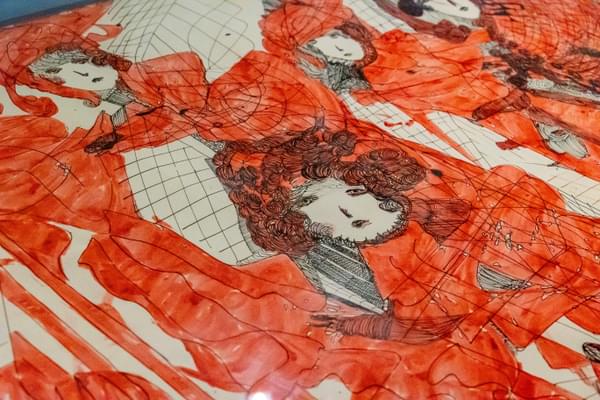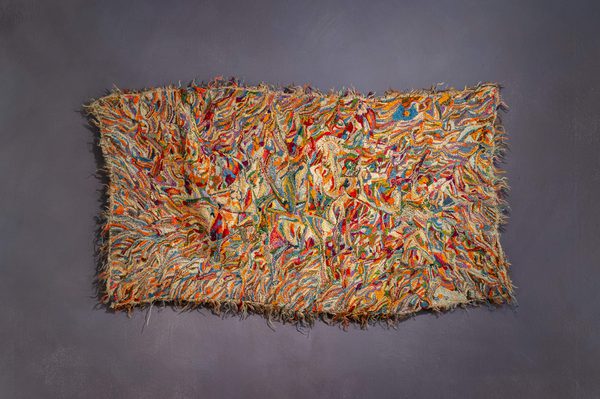News Story

The remarkable life of the self-taught artist
Words by Eibhlín Kissack & Sophie Dutton
The Clouds Will Burst the Sun Will Shine Again featured an extensive collection of work by self-taught artist Madge Gill (1882 – 1961). The exhibition collates significant works by the celebrated ‘Outsider’ artist, who took inspiration from spirituality and nature.
An ‘Outsider’ artist is a term used to describe an artist, who has not had formal training or worked within conventional structures of art production, and often does not engage with the mainstream art world.
With a quality of instinctive urgency, Gill’s works are experimental and explorative, ranging from mediumistic drawings in ink and pencil, to large-scale textile artworks that span the length of the gallery walls. The exhibition’s connection to Birmingham is woven through a personal relationship to the work held by Birmingham-born curator, Sophie Dutton. Sophie discovered the work of Gill through a familial connection, leading to a substantial research project on the late artist that informs the exhibition.
The pieces on display resonate with MAC’s wider autumn programme, focused on the role of art and nature on our wellbeing. Key themes of spirituality, pain, and nature in The Clouds Will Burst the Sun Will Shine Again, closely link to themes within the exhibitions Worlds Away and Watershed, concurrently on display. Gill’s drawings, paintings and embroidery feature repetitive patterns of flowers, swirling shapes, female faces and figures – and are intrinsically linked with the turmoil Gill experienced throughout her lifetime.

Sophie’s father, Clive Dutton OBE, was an internationally-recognised urban regeneration and planning expert. He worked as Executive Director of Regeneration and Planning at Birmingham City Council and delivered an ambitious redevelopment plan for the city, which led to significant economic and social renewal. His work included the redevelopment of Birmingham New Street railway station, the creation of the Library of Birmingham, and securing essential new investment for Birmingham from 2005 onwards. In 2009, he began working at the London Borough of Newham Council on the revitalisation of the Royal Docks. During this time, Clive came across Madge’s work in their archive.
“He called me afterwards – he was so excited about how remarkable her work was,” Sophie says, “We talked about her art, and how striking it was. I was unaware of Gill’s backstory at this point.”
In 2015, her father passed away and Sophie arranged to see the work for herself at Stratford Library.
“I wanted to see what had excited him so much. I was really blown away by the work and from talking to the archivists, there seemed to be many unknowns about Madge Gill. I began meeting more people connected with her work, and those who had other collections - the project spiralled from there.
“It started as a personal project, it wasn’t about carrying on my father’s interest: Gill’s art and story had really taken hold in my heart, in part because the more I researched her life, the more I realised the extent to which Gill had painted her way out of grief and found a creative outlet for her emotions. Within this, I found a real sense of hope.”
Following a small arts development grant from Newham Council, Sophie was able to further develop her research and hold community-based workshops inspired by Gill, before a blue plaque was installed on the flat Gill was born in. In 2019, an exhibition at the William Morris Gallery curated by Sophie led to the discovery of Gill’s embroidery works – many of which were largely believed to have been lost.

Sophie said, “I quickly found her story had an impact on others. When I held workshops, or spoke to people with or without a connection to her - her artwork acted as a gateway for others to express their stories, I've found people really connect with her on so many levels, and in turn open up themselves.
"I never thought I'd be curating exhibitions or writing articles or a book about her. It's a really special moment for it to be coming to Birmingham and MAC.”
Gill faced hardships in her life, including severe mental health challenges. Her artistic production increased substantially during the 1930s, and she began creating ink drawings on postcards, sheets of card, and long rolls of untreated calico cloth. Gill worked for hours and often overnight on her pieces, and rarely parted with her works. Her lifetime body of work remained largely intact and kept in her East Ham house at the time of her death. Works were found stored all over the house in cupboards, under the bed, and in the attic, demonstrating the sheer volume of art Gill created during her life.
This extraordinary collection of work explores the cathartic act of making and creating, and investigates the role of art and nature for our wellbeing.